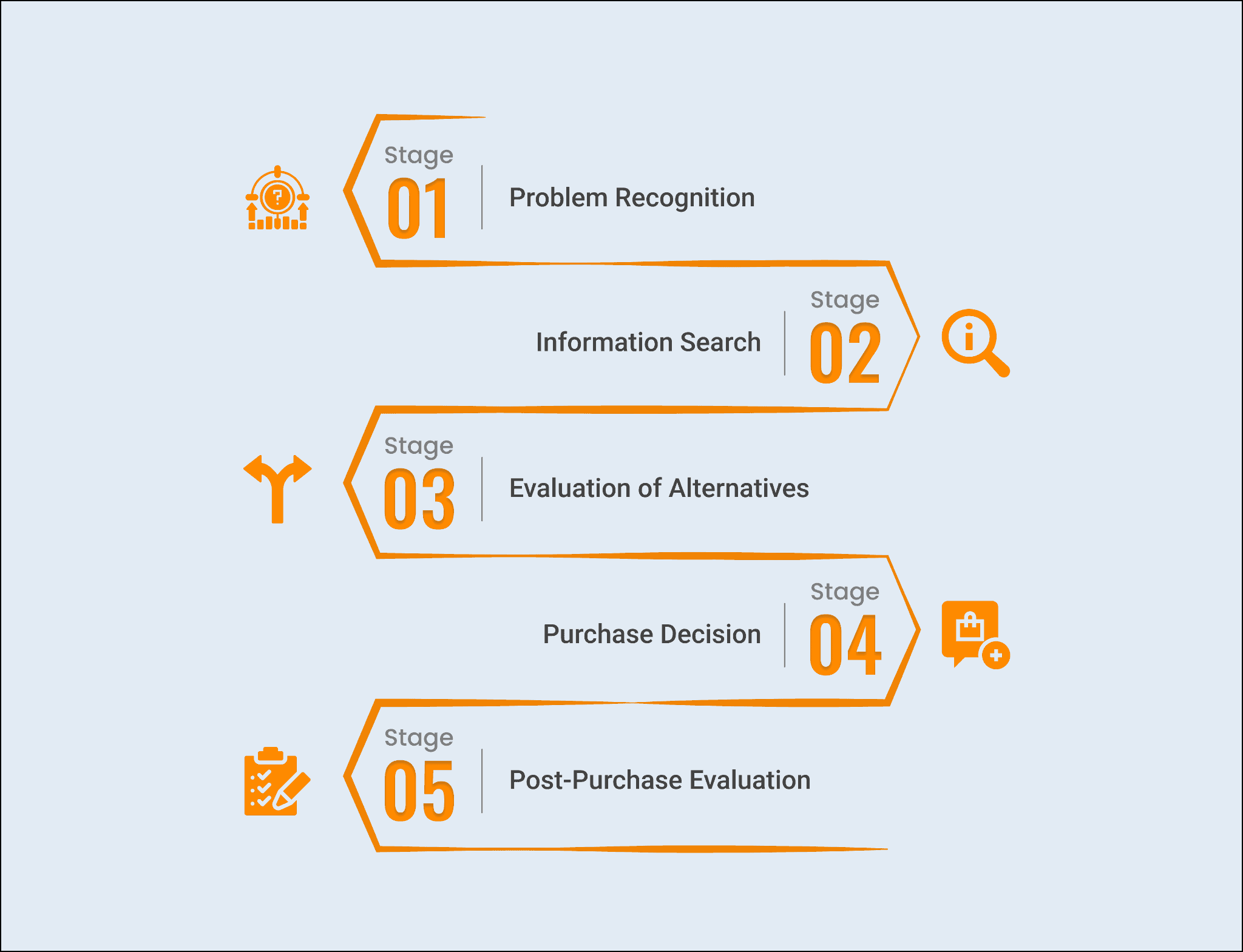Are you a business owner looking to increase sales and reach more customers?
In today’s digital age, social media shopping has become a popular way for consumers to make purchases. But how do consumers make decisions when shopping on social media?
Understanding the consumer decision-making process is crucial for businesses looking to succeed in the world of social media shopping.
A thorough comprehension of the psychology behind consumer behavior enables businesses to customize their strategies to better meet the needs and desires of their target audience.
In this blog post, we will explore the psychology of social media shopping and the consumer decision-making process. We will also provide examples of brands that have successfully utilized social media shopping strategies and discuss potential ethical concerns.
So, let’s dive in and explore the world of social media shopping!
5 Stages of the Consumer Decision-Making Process
Consumers go through a five-stage decision-making process when making a purchase. Understanding these stages can help businesses effectively engage with customers on social media.
Let’s explore each stage in detail:

Stage 1: Problem Recognition
The consumer decision-making process begins with problem recognition, where individuals identify a need or desire that prompts them to make a purchase.
Various factors, such as an actual problem, a desire for improvement, or external influences like advertisements or social media content can trigger this recognition. A brilliant example of this is tl;dv, which raises awareness of the Problem they are solving (Meeting inefficiency) with humorous video content, engaging several 10,000s of potential buyers in their target group organically.
| Problem Recognition |
|
|---|
Stage 2: Information Search
After recognizing the problem or desire, consumers embark on an information search to gather relevant details about potential solutions.
| Information Search |
|
|---|
This search can involve researching product specifications, reading online reviews, seeking recommendations from friends or influencers, and exploring social media platforms for insights and opinions.
High-quality product descriptions and Google Ads are crucial during the initial stages of customer decision-making, as they provide detailed information, evoke emotions, and trigger the purchase intent.
A brilliant AI writing tool can construct captivating, focused, and accurate product descriptions and Google Ads, generating higher engagement, conversion rates, and overall brand growth.
Social media plays a significant role during this stage, as consumers can engage with brands, ask questions, and gather real-time information.
Stage 3: Evaluation of Alternatives
Once consumers have gathered sufficient information, they proceed to evaluate the available alternatives.
| Evaluation of Alternatives |
|
|---|
This stage involves comparing different products or brands based on various factors, such as price, quality, features, reputation, and customer reviews.
Social media platforms provide consumers with the opportunity to access user-generated content, product demonstrations, and comparisons, enabling them to make more informed decisions.
Stage 4: Purchase Decision
After evaluating the alternatives, consumers reach the purchase decision stage. At this point, they have selected a specific product or brand that aligns with their needs and preferences.
| Post-Purchase Evaluation |
|
|---|
Factors influencing the purchase decision can include pricing, promotions, perceived value, trust in the brand, and social proof.
Social media platforms often offer convenient purchasing options, such as integrated shopping features or links to online stores, e-commerce websites, or an e-commerce website builder, making it seamless for consumers to complete the purchase.
Stage 5: Post-Purchase Evaluation
The consumer decision-making process doesn’t end with the purchase; it extends to the post-purchase evaluation stage.
Consumers reflect on their buying experience and assess whether the product or brand met their expectations.
| Post-Purchase Evaluation |
|
|---|
This evaluation influences their future decisions, brand loyalty, and potential recommendations to others. Social media allows consumers to share their experiences, provide feedback, and engage in conversations with brands and other consumers.
Social media plays a crucial role in each stage of the consumer decision-making process. For example, during the information search stage, consumers may turn to social media platforms like Instagram to gather information about potential solutions to their problems.
They may look at product photos, read reviews, and check out brand accounts to learn more about their options.
According to a survey by Sanity, 78% of American consumers say they’ve discovered new products on Facebook, and 59% have discovered products on Instagram.
This highlights the importance of businesses having a strong social media presence in order to be discovered by potential customers.
“Social media has drastically changed the way consumers make purchasing decisions. Businesses that understand this and tailor their strategies accordingly are the ones that will thrive in today’s digital age.” – Tuhin, Co-founder of LondonAppDevelopment (LAD)
In the evaluation of alternatives stage, social media can also play a role in helping consumers compare options. They may use platforms like Pinterest to create boards comparing products and features.
This highlights the importance of businesses providing clear and detailed information about their products on social media platforms.
The tweet from Lisa Goller highlights the partnership between Amazon and Pinterest, which is a major development in the convergence of social media and eCommerce.
It’s pretty evident that social media has become a crucial aspect of modern-day shopping. #Pinterest, being a highly popular platform for shoppable content, presents a promising opportunity for #Amazon to extend its reach & broaden its influence.
— Anil Patel (@anilpatelhwc) May 9, 2023
The Psychology of Social Media Shopping
The Role of Emotions in Consumer Decision-Making
Emotions play a critical role in the decision-making process of consumers. Social media platforms offer a unique opportunity for businesses to appeal to consumers’ emotions and create a lasting impression.
According to a study by Inc., 75% of consumers make purchasing decisions based on their emotions. Brands that can create emotional connections with their audience are more likely to see increased engagement and sales.
Calculate the result: Perform the calculation using the formula and the collected data to obtain the engagement rate.
For example, if you had 500 engagements and a total reach of 10,000, the engagement rate would be:
| Engagement Rate = (500 / 10,000) * 100% = 5% |
|---|
The Impact of Social Influence and Social Proof on Buying Behavior
Social Influence and social proof refer to the tendency of people to follow the actions or opinions of others. Social media provides an ideal platform for businesses to leverage these concepts by showcasing customer reviews, ratings, and endorsements from influencers.
For instance, a restaurant might showcase positive reviews from satisfied customers or feature photos of popular dishes to encourage others to visit.
| Social Influence Score = (Number of Social Media Mentions / Total Reach) * 100% |
|---|
The Power of Personalized Recommendations and User-Generated Content
Social media allows businesses to provide personalized recommendations to their customers based on their interests and past behavior.
By analyzing a customer’s past purchases, businesses can recommend similar products or services that the customer is likely to enjoy.
| Personalized Recommendation Score = (Customer Interests + Past Behavior) * Product Similarity Index |
|---|
Additionally, user-generated content such as social media reviews and social media posts can help build trust and credibility with potential customers.
For example, a beauty brand might share user-generated photos of customers using their products to showcase the quality and effectiveness of their offerings.
User-generated content is another powerful tool for driving sales and increasing engagement on social media.
Brands can encourage customers to create and share their own content, such as reviews or images of themselves using a product. This creates a sense of community and social proof around the brand, which can lead to increased engagement and sales.
Brands Utilizing Social Media Shopping Strategies
Social media has become a vital platform for brands to connect with consumers and drive their shopping experiences.
Here are three examples of brands effectively utilizing social media shopping strategies:
Example #1: Sephora’s use of Instagram to showcase products and connect with customers
Sephora, a renowned beauty retailer, has mastered the art of utilizing Instagram to engage with their customers and showcase their products.
By leveraging visual content and user-generated posts, Sephora creates an immersive experience for its audience.
They strategically feature high-quality images and videos of their products, capturing attention and stimulating desire among potential buyers by sending out marketing emails. To achieve their marketing goals to the fullest, they make use of a clever strategy that involves leveraging the power of email marketing in conjunction with Instagram.

Moreover, Sephora engages in two-way communication by actively responding to comments and direct messages on Instagram.
They address customer inquiries, offer personalized product recommendations, and provide assistance, which enhances the shopping experience and strengthens customer loyalty.
Through its social media presence, Sephora successfully taps into the emotional aspects of consumer decision-making.
By presenting visually appealing content and fostering a sense of community, they create an environment where customers feel connected to the brand and are more inclined to make purchases.
Example #2: Adidas’ use of personalized recommendations on their website
Adidas, a leading sportswear brand, understands the power of personalized recommendations in influencing consumer behavior.
On its site, Adidas utilizes sophisticated algorithms to analyze user preferences, browsing history, and purchase patterns. Based on this data, they offer tailored product recommendations to individual shoppers.

Adidas: Asking for Assistance with Site Personalization
By implementing this strategy, Adidas enhances the shopping experience by presenting consumers with relevant and appealing options.
Personalized recommendations create a sense of convenience and assist customers in finding products that align with their specific needs and preferences.
This approach not only increases the chances of conversion but also promotes customer satisfaction and loyalty.
Adidas’ effective use of personalized recommendations demonstrates its understanding of the consumer decision-making process.
By leveraging data-driven insights, they anticipate customer preferences, streamline the shopping journey, and provide a more personalized and enjoyable experience.
Example #3: Starbucks’s use of user-generated content to showcase its products
Starbucks is a prime example of a brand that effectively harnesses the power of user-generated content (UGC) to showcase its products and engage with its customers.
By reposting photos taken by their customers on platforms like Instagram, Starbucks creates a sense of authenticity and social validation.
For instance, let’s take a look at an Instagram post by Starbucks. They have reposted a captivating photo of a delicious cup of coffee, beautifully captured by one of their customers.
This UGC not only showcases the quality and appeal of Starbucks’ products but also adds a personal touch. Seeing a real customer’s photo makes the brand feel more relatable and trustworthy.

When Starbucks reposts its customers’ content, it not only promotes its products but also makes the customer feel appreciated.
By taking the time to recognize and share its image, Starbucks acknowledges and values its contribution. This gesture of appreciation strengthens the bond between the brand and the customer, fostering a sense of loyalty and encouraging future engagement.
By understanding the psychology behind social media shopping, businesses can enhance their strategies and forge stronger connections with their target audience.
Ethical Considerations in Social Media Shopping
As social media shopping continues to gain popularity, it’s important to address the ethical considerations associated with this phenomenon.
Businesses must be aware of potential ethical concerns and take necessary measures to ensure transparency and maintain consumer trust.
The following aspects are worth considering:
1. Misleading Advertising
Social media platforms provide businesses with ample opportunities to promote their products or services.
However, there is a risk of misleading advertising, where businesses may exaggerate the benefits or features of their offerings, leading to false expectations among consumers.
It is crucial for businesses to maintain honesty and accuracy in their promotional content, ensuring that it aligns with the actual attributes of the product or service being advertised.
2. Data Privacy
Social media platforms collect vast amounts of user data, including personal information and online behavior.
While this data is valuable for businesses to personalize recommendations and target specific audiences, it raises concerns about data privacy.
Businesses must prioritize data protection and adhere to strict privacy policies to safeguard consumer information.
Being transparent about data collection practices and obtaining explicit consent from users can help build trust and maintain a positive brand image.
3. Transparency & Consumer Trust
Transparency is key to maintaining consumer trust in social media shopping. Businesses should strive to provide clear and accurate information about their products, pricing, and policies.
Openly addressing any potential limitations or drawbacks of their offerings can help prevent dissatisfaction and increase customer experience for eCommerce.
Building trust goes beyond providing accurate information. It also involves actively engaging with customers, addressing their concerns, and being responsive to their feedback.
Encouraging open communication and fostering a positive brand image can help establish long-term relationships with customers and enhance their confidence in making purchases through social media platforms.
Psychology of social media shopping
Understanding the psychology of social media shopping and the consumer decision-making process is essential for businesses aiming to thrive in the digital marketplace. Let’s recap the key points discussed throughout this article:
Emotions play a crucial role in consumer decision-making. Businesses can leverage social media platforms to create emotional connections with their audience, using visually appealing content and storytelling techniques to evoke positive emotions and drive engagement.
Social influence and social proof greatly impact buying behavior. User-generated content (UGC) and personalized recommendations have a significant influence on consumers’ purchasing decisions.
By encouraging customers to share their experiences and utilizing algorithms to provide tailored recommendations, businesses can leverage social media to enhance their credibility and drive conversions.
Ethical considerations are vital in social media shopping. Businesses should prioritize transparency, honesty in advertising, and data privacy to foster trust with consumers.
By maintaining ethical practices, businesses can build long-term relationships and positive brand images.
Implications for businesses
Understanding the consumer decision-making process on social media platforms opens up a world of opportunities for businesses. By incorporating the following strategies, businesses can effectively harness the psychology of social media shopping:
- Craft compelling visual content
Invest in high-quality images, videos, and interactive content that resonate with your target audience’s emotions. Use storytelling techniques to create a memorable brand experience. Use AI tools, such as an AI image generator to enhance your brand aesthetics and engage your audience with unique visuals. Use storytelling techniques to create a memorable brand experience.
- Foster social proof and user-generated content
Encourage customers to share their experiences and reviews on social media. Incorporate UGC in your marketing campaigns to build trust and credibility.
- Personalize the shopping experience
Leverage data analytics and information from internal tools or integrated systems, like Salesforce and Google Analytics, to better understand individual customers and close deals more quickly.
This tailored approach enhances customer satisfaction and increases the likelihood of conversions.
- Prioritize transparency and data privacy:
Clearly communicate your business practices, pricing, and policies to build trust with consumers. Implement robust data protection measures to safeguard customer information.
Final thoughts and recommendations
As social media continues to shape the consumer landscape, businesses must adapt and embrace the psychology of social media shopping. Stay updated with the latest trends, continuously analyze consumer behavior, and be willing to experiment with innovative strategies.
Moreover, regularly monitor and engage with your audience on social media platforms. Actively respond to feedback, address concerns, and cultivate a positive brand image.
By understanding the psychology behind social media shopping, businesses can effectively connect with their target audience, drive engagement, and ultimately increase conversions.
Embrace the power of social media and consumer psychology to position your business for success in the ever-evolving digital landscape.
Remember, success in social media shopping lies in the ability to understand, engage, and cater to the needs and preferences of your customers.
With the right strategies and a deep understanding of the consumer decision-making process, businesses can thrive in the competitive world of social media shopping.
